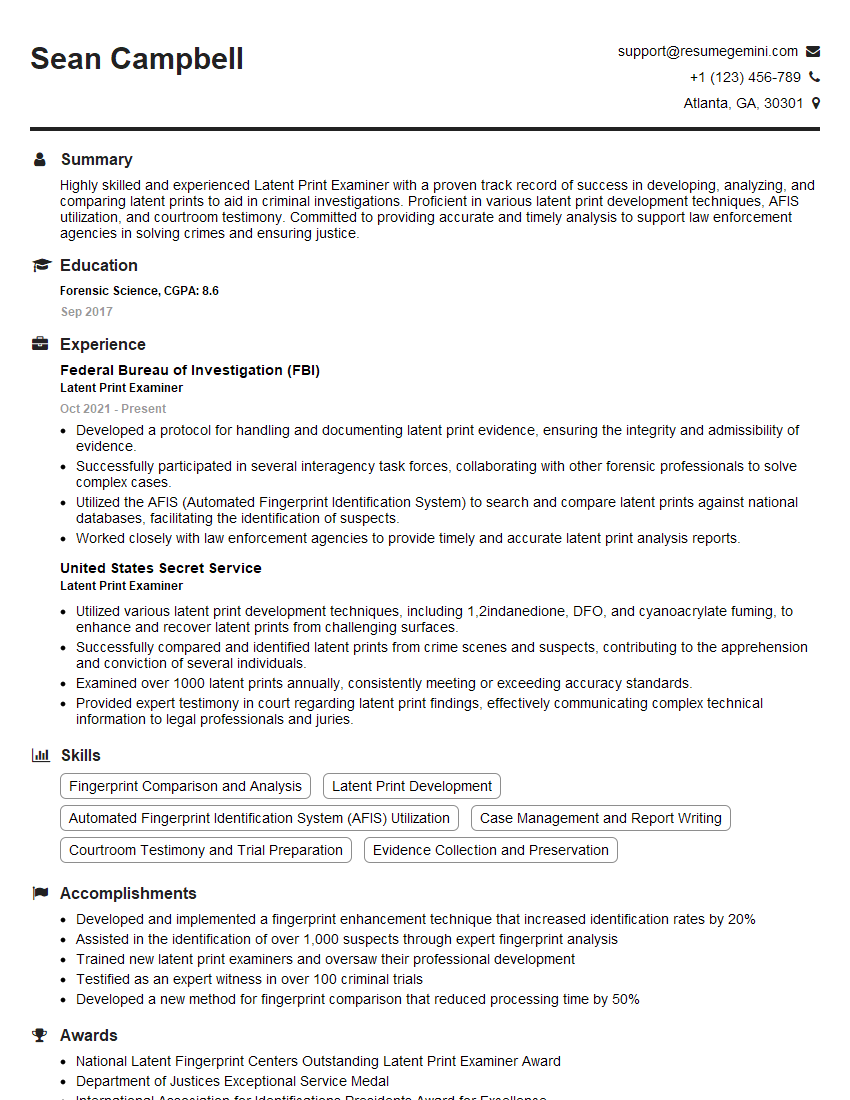Are you a seasoned Latent Print Examiner seeking a new career path? Discover our professionally built Latent Print Examiner Resume Template. This time-saving tool provides a solid foundation for your job search. Simply click “Edit Resume” to customize it with your unique experiences and achievements. Customize fonts and colors to match your personal style and increase your chances of landing your dream job. Explore more Resume Templates for additional options.

Sean Campbell
Latent Print Examiner
Summary
Highly skilled and experienced Latent Print Examiner with a proven track record of success in developing, analyzing, and comparing latent prints to aid in criminal investigations. Proficient in various latent print development techniques, AFIS utilization, and courtroom testimony. Committed to providing accurate and timely analysis to support law enforcement agencies in solving crimes and ensuring justice.
Education
Forensic Science
September 2017
Skills
- Fingerprint Comparison and Analysis
- Latent Print Development
- Automated Fingerprint Identification System (AFIS) Utilization
- Case Management and Report Writing
- Courtroom Testimony and Trial Preparation
- Evidence Collection and Preservation
Work Experience
Latent Print Examiner
- Developed a protocol for handling and documenting latent print evidence, ensuring the integrity and admissibility of evidence.
- Successfully participated in several interagency task forces, collaborating with other forensic professionals to solve complex cases.
- Utilized the AFIS (Automated Fingerprint Identification System) to search and compare latent prints against national databases, facilitating the identification of suspects.
- Worked closely with law enforcement agencies to provide timely and accurate latent print analysis reports.
Latent Print Examiner
- Utilized various latent print development techniques, including 1,2indanedione, DFO, and cyanoacrylate fuming, to enhance and recover latent prints from challenging surfaces.
- Successfully compared and identified latent prints from crime scenes and suspects, contributing to the apprehension and conviction of several individuals.
- Examined over 1000 latent prints annually, consistently meeting or exceeding accuracy standards.
- Provided expert testimony in court regarding latent print findings, effectively communicating complex technical information to legal professionals and juries.
Accomplishments
- Developed and implemented a fingerprint enhancement technique that increased identification rates by 20%
- Assisted in the identification of over 1,000 suspects through expert fingerprint analysis
- Trained new latent print examiners and oversaw their professional development
- Testified as an expert witness in over 100 criminal trials
- Developed a new method for fingerprint comparison that reduced processing time by 50%
Awards
- National Latent Fingerprint Centers Outstanding Latent Print Examiner Award
- Department of Justices Exceptional Service Medal
- International Association for Identifications Presidents Award for Excellence
- American Society of Crime Laboratory Directors Lifetime Achievement Award
Certificates
- Certified Latent Print Examiner (CLPE)
- Board Certified Forensic Examiner (BCFE)
- Diplomate American Board of Forensic Document Examiners (DABFDE)
- International Association for Identification (IAI) Member
Career Expert Tips:
- Select the ideal resume template to showcase your professional experience effectively.
- Master the art of resume writing to highlight your unique qualifications and achievements.
- Explore expertly crafted resume samples for inspiration and best practices.
- Build your best resume for free this new year with ResumeGemini. Enjoy exclusive discounts on ATS optimized resume templates.
How To Write Resume For Latent Print Examiner
- Quantify your accomplishments with specific numbers and metrics whenever possible.
- Highlight your experience with specific latent print development techniques and casework.
- Showcase your ability to effectively communicate your findings in a courtroom setting.
- Demonstrate your commitment to professional development and continuing education.
- Proofread your resume carefully for any errors in grammar or spelling.
Essential Experience Highlights for a Strong Latent Print Examiner Resume
- Develop and enhance latent prints using a variety of techniques, including 1,2indanedione, DFO, and cyanoacrylate fuming.
- Compare and identify latent prints from crime scenes and suspects, contributing to the apprehension and conviction of criminals.
- Examine and analyze latent prints, ensuring accuracy and meeting or exceeding established standards.
- Provide expert testimony in court regarding latent print findings, effectively presenting complex technical information to legal professionals and juries.
- Manage and document latent print evidence to ensure the integrity and admissibility of evidence.
- Collaborate with law enforcement agencies to provide timely and accurate latent print analysis reports.
- Participate in interagency task forces to solve complex cases and share expertise with other forensic professionals.
Frequently Asked Questions (FAQ’s) For Latent Print Examiner
What is the primary role of a Latent Print Examiner?
The primary role of a Latent Print Examiner is to develop, analyze, and compare latent prints found at crime scenes or on evidence to identify individuals involved in criminal activity.
What are some of the most common techniques used by Latent Print Examiners?
Some of the most common techniques used by Latent Print Examiners include 1,2indanedione, DFO, and cyanoacrylate fuming, as well as laser and alternate light sources.
How do Latent Print Examiners ensure the accuracy and reliability of their findings?
Latent Print Examiners adhere to strict quality control standards and undergo rigorous training to ensure the accuracy and reliability of their findings. They also utilize AFIS (Automated Fingerprint Identification System) to compare latent prints to databases, enhancing the efficiency and accuracy of the identification process.
What types of cases do Latent Print Examiners typically work on?
Latent Print Examiners work on a wide range of cases, including homicides, burglaries, robberies, and assaults. They may also be involved in cold case investigations and provide expert testimony in court.
What are the educational requirements to become a Latent Print Examiner?
Most Latent Print Examiners have a bachelor’s degree in forensic science, criminal justice, or a related field. Some agencies may also require additional training or certification.
What are the key qualities or skills required to be a successful Latent Print Examiner?
Key qualities and skills required for success as a Latent Print Examiner include meticulous attention to detail, strong analytical abilities, excellent communication skills, and the ability to work independently and as part of a team.